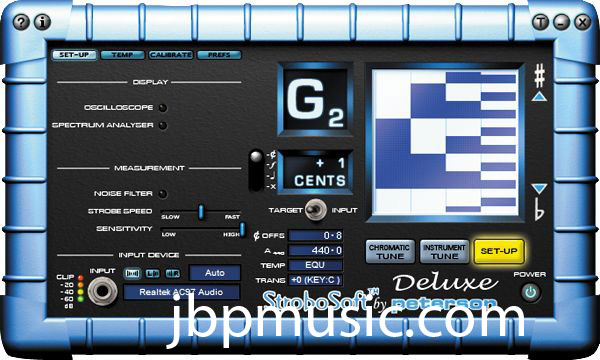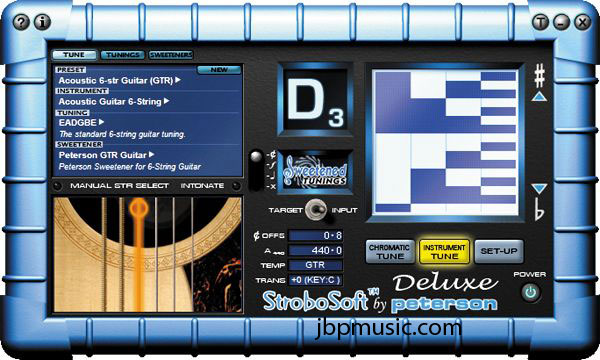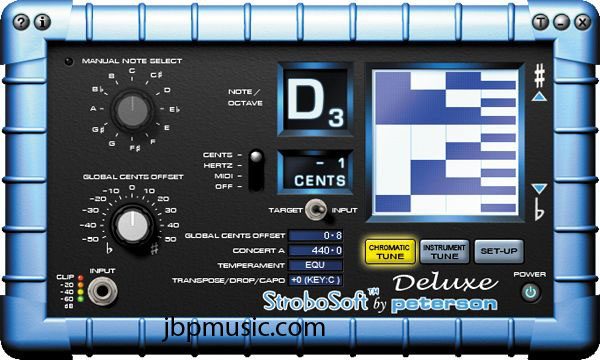Peterson Tuners StroboSoft Tuning Software Review
I record many different types of music via my computer. I use guitars, basses, keyboards, and mic-recorded vocals and acoustic sounds/instruments. I am constantly in need of a tuner which keeps me from having to worry about intonation issues.
Guitars (the whole family, basses, 6-strings, 7-strings, exotics) and just about every stringed instrument are not
well-tempered.
Read about instrument tempering here. It's fascinating - opens new window. Sometimes, just tuning your instrument to the exact correct chromatic pitches isn't going to give you better sound - "in tune", yes, better sound, no. I've fought the tunings of my guitars for ages (particularly acoustics). Tune up to the correct notes, play three different tracks together with the exact same instrument and the exact same tuning - sometimes the three tracks played together don't sound too good. Why? Tempering. Lack of sweetening.
If you want to tune to the exact pitches your instrument plays, then the StroboSoft sofware (and Peterson's peerless hardware tuners) will give you just what you want, down to the cent (a cent is effectively a hundredth of a tone). But, some technologies help you by giving you "sweetened tunings" - these tunings include the famous and wonderful Buzz Felten tuning system sweetening settings. There are other excellent tunings available to warm and broaden your harmonic and melodic sounds. With StroboSoft, you can spend your time with your music, not with fiddling with your tuner for hours on end.

Peterson's hardware strobe tuners are the best of the best of the best. I've been interacting with them since I was in school band back in the seventies. Recent Peterson Tuners for guitar, bass and other stringed instruments include sweetened tunings. StroboSoft Deluxe also includes sweetened tunings - all of which work
WONDERS for your music and your ears!
Free Shipping and more information for Peterson StroboSoft
If you'd like to read more about StroboSoft in detail, you can visit the StroboSoft site here:
StroboSoft.
Quick Opinion: Buy this piece of software. Buy this piece of software. Buy this piece of software. Really: Buy this piece of software. Your music will sound better, your music will flow better, you'll have more time to work on your music...
If you're gigging, playing outside a studio, or on the road - invest in a hardware Peterson Tuner (and take StroboSoft's capability with you). The hardware tuners are more expensive than the average hardware tuner, but they are worth it. At some point, I'm going to save up enough sheckels and buy a StroboStomp or the rack version for myself... Their hardware is well worth twice (or more) than their current street prices.
If I can get my paws on a Peterson hardware tuner in the near future, I will write an extensive review of it, as well.
 Features:
Features: StroboSoft is a snap to use. Install it, go to the setup tab, select your instrument input hardward device, click on "Instrument tune", then choose what kind of tuning you want (6 String electric? 6 String Acoustic? Sweetened? 5 String Bass?). Pluck your strings, and work your tuners/slides/instrument tuning device until the strobe stops moving up or down. You're done.
Set up for the first time takes very little time. Just take a few minutes to read their introduction, set it up, and GO. YOUR music will be sweeter, warmer, and more natural-sounding in a few minutes. Be sure to check out and set up the noise canceling feature (so it can tune easier, even on a noisy guitar or mic) - once you're up and running and understand what the tuner's doing.
Quality: I have had no issues whatsoever with StroboSoft on any of the three computers I use for recording. It has never crashed, misbehaved, or given me the first issue. Flawless.
In case you're wondering, this review is glowing because the product
REALLY deserves it - not because of any other factor.
 Value:
Value: In my opinion, this software is worth at least as much as Peterson Tuners' StroboFlip and StroboStomp hardware. I'm very impressed (and, frankly very, very happy) that it costs so little. The forums get answered, the emails get answered, the folks at Peterson care about their customers, and you cannot find a better value on the market.
Period.
Wishes: I'd love to see a Mac OSX dashboard widget interface to StroboSoft... just a thought...
Labels: 4 string bass, acoustic bass, acoustic guitar, computer recording, electric guitar, jimmy pearson, macintosh, osx, peterson, software, strobosoft, tuner, tuning, violin, vista, windows, xp
Dean Playmate EAB Acoustic Electric Bass Hands-on Review
 Dean Playmate EAB Acoustic Electric Bass Review
Dean Playmate EAB Acoustic Electric Bass Review
Due to popular request and to help a little with the folks who want to hear the bass first-hand, I've uploaded another tune I recorded with my Dean EAB (the bass part). I still have the EAB (I go through lots of instruments), and I love it. This recording is a mixture between the acoustic bass and an electric semi-hollow body guitar (an Ibanez AF75D). The bass part is recorded here in my home with two Nady condenser reference mics, through a nice tube pre-amp. I chose not to use the on-board pickup because I like the acoustic sound so much.
Listen here (new window). Please feel free to share the tune, but please tell folks where you got it! It's not public domain, just free for personal use only. Any public or commercial use requires my express written permission. For more of my music, including some acoustic stuff recorded with my EAB, go to (new window)
http://jbpmusic.com.
As a recording musician, I like to have lots of different sound timbres and qualities in my "library" of guitars. Since I have a couple of nice electric basses, I began looking for a low-cost acoustic bass guitar some time ago. I played $2000 basses, and I played $99 basses at different guitar stores in our area. The top-end basses such as the Tacoma were wonderful, but were
way out of my budget. By far, the
Martin (wow! Solid sound, excellent build, bar-none timbre) and
Tacoma Thunderchief (wow! If I could afford one of these, it would be THE one!) guitars were the best sounding and the best made. Either brand, in any model, would have been a great joy to own! I also played the Fender, Ibanez, and Kelly acoustic basses – but they were above my budget as well.
My issue, however, is that I wanted a bass that sounded great
acoustically, and if it worked amplified too, then fine – and at a low price. This brought me to the Dean Playmate EAB. This bass, at $149 through sites like
Purchasing and information link plus get Free Shipping at GuitarCenter.com
was an absolute (pleasant) surprise. I ended up purchasing the Dean as my bass acoustic member of my sound palette. If you’d like to hear how it sounds when recorded through a nice acoustic microphone, go to this page:
http://jimmybear.dmusic.com and listen to
Gentle Falling Snow.
Quick Opinion: The Dean Playmate EAB Acoustic Electric Bass is a great all-around acoustic bass. It handles well, is of OK quality, and (most of all) sounds along the lines of the marvelous Tacoma acoustic basses. The primary impression of the Dean EAB Bass we bought (and have played for almost a year) is that it is a
steal of a buy, and a very interesting-sounding bass.
Playability: The Dean EAB has a long-scale neck. It feels right at home after playing my Fender American Standard Jazz bass (although the Jazz is a much easier instrument to play, and has a better neck). The frets are surprisingly well set, dressed, and are of reasonable height. The light-brown/red fretboard wood is a little dry looking, but it is very easy to play. The body size is comfortable for a tall person with long arms (such as myself). My son feels comfortable with the guitar, but my daughter ("only" 5’10") isn’t comfortable with the large and deep body. (Body size is not "good" or "bad", the Dean is about the same size as the Tacoma… It is just not comfortable for smaller players.) The string height is surprisingly low, even after I raised the strings a bit to reduce fret buzz.
The Dean’s playability is actually a high 8 or low 9. Especially after a string-change.
Features The features of the Dean Playmate EAB are reasonable. The tuners are good and strong (sort of Gotoh-style), and keep tune
very well. The rosette is traditional in look, and the saddle wood is of a very contemporary shape. The string-retention pegs are large and easy to use, and provide sufficient mass for reasonable sound (Why is it that I can’t find brass, bone, or Tusq retention pegs in the aftermarket? I’d buy some if I could find them.)
The satin finish is even, well-applied, and has very few "weird" spots. The neck’s satin finish is much smoother than the body’s finish, and is very comfortable in the hand. The Dean came with OK nickel or steel wrapped strings – they were a bit bright for me… I changed our Dean’s strings to a set of
D’Addario Phosphor Bronze soft strings (the
Martin Phosphor Bronze lights sound
really great, too – they just lose their warm, growly timbre quicker and seem to oxidize quicker.)
Sound: This is where the Dean Playmate EAB sold me: Sound. The
acoustic sound is extremely comparable to solid-wood guitars from a
much higher price range! The bass frequencies are pretty tight, and the reproduction of the string flutter comes out nice and clear. The sound is pretty good when playing up the neck, especially when I switched from nickel to phosphor-bronze strings. When correctly mic-ed, the Dean sounds so very clear and wonderful – almost as rich as a grand piano with its top open.
The electronic sound (through the passive saddle pickup) is not up to snuff, though… see the "Wishes" section of this review.
The sound of the Dean was far better than any of the $300-$600 guitars I played.
Value: This is a $300 guitar in value (not 'retail',
'street'). The acoustic sound alone, plus the nicely (comparatively) finished neck are worth more than the price of admission alone. If I were to lose this one, I would most surely buy another, even if I sold enough music to buy a Martin or Tacoma.
Wishes: There are two major concerns, and one minor concerns. These concerns are apparent not after a quick use at the guitar store, but from recording more than 10 pieces of music with the Dean EAB…
The neck is slightly warped at about the third fret. After adjusting the string height (and the neck’s overall bow from shipment), it is apparent that the truss rods aren’t the most supportive in the world. The good news, however, is that the warp is slight, doesn’t affect my playing too much, and it has not changed in the nearly yearlong time in my guitar library. I find this particular warp to be acceptable for a guitar of this price. If this were a guitar that was more than $300, I would have looked for another.
The guitar’s sound through the electronics is not very good. Even with the tone turned all the way down, and the volume nearly all the way down, the bass sounds like telephone wires being pinged (think: Star Wars sounds). I had to run it through a tube preamp and several equalizations before I liked the electronic sound at all. As it is, I do not use it electrically – only acoustically. Since my Shure SM57 does a great job mic-ing the guitar, and I can get great, CLEAN bass sound with my MXL 990 with my BlueTube preamp, I have stopped trying to use the on-board electronics.
I love my Dean EAB. I
really do. I hope I get to use it for many years to come – I just wish the finish was glossy. I also placed a pickguard on it to protect it for those rare times when I use a pick for clear attacks.
Labels: 4 string bass, acoustic bass, bass, dean, eab, piezo, playmate




